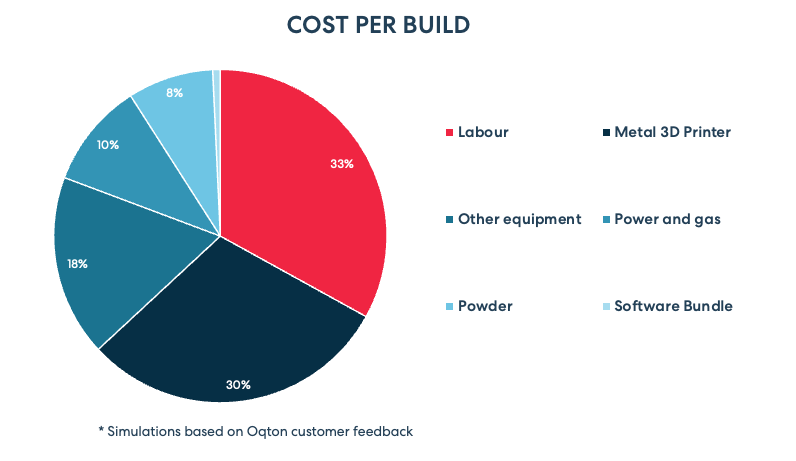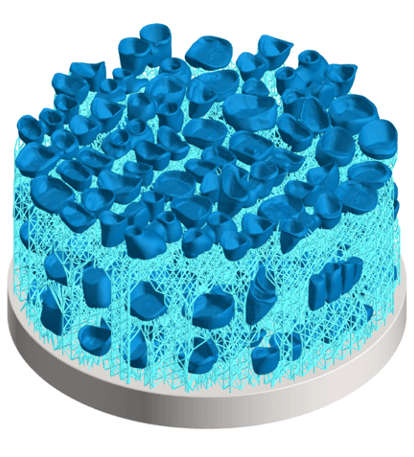Metal 3D printing and dentistry – how to automate data preparation with a Manufacturing OS
Metal additive manufacturing (AM), or 3D printing, is a technology commonly used in dentistry to make crowns, bridges, orthodontic bands and Removable Partial Dentures (RPD) frames.
Compared to zirconia milling, metal printing requires a significant investment. This also means that automation is a hugely important way of achieving savings.
In this instalment of our series on how the Manufacturing OS helps dental labs, we focus on metal 3D printing.
The challenges in metal 3D printing
The advent of digitisation in dentistry has opened new possibilities for faster and better production of dental applications – but it also came with teething problems.
To use a CNC milling machine or 3D printer, staff in dental labs need to master complicated and fragmented software. The general lack of trained staff in today’s labour market is proving to be an obstacle to growth for dental labs, and metal 3D printing comes with an additional set of challenges.
The lion’s share of a metal build's cost comes from two components – the printer and the labour. We have outlined the costs in the chart below based on our simulations and customer feedback.

Adding metal 3D printing to your lab implies another new technology and traditionally a new piece of software your technicians need to get familiar with, more files for them to handle, and subsequently, file management time will balloon as well.
It would make sense to hire more staff, but knowledge of metal 3D printing in dentistry is rare, and mastering these skills involves a steep learning curve.
High labour costs mean there is ample opportunity to increase profitability by reducing human intervention. Most of the work in metal 3D printing is data preparation, machine loading and unloading, removing the parts from the build plate, and support removal.
By automating any of these actions, dental labs could significantly reduce cost per part.
This is where a Manufacturing OS has helped dental labs to unleash the full potential of 3D printer use in dentistry.
What is a Manufacturing OS?
To help dental labs automate and optimise their production, we’ve created a unified platform with simple workflows for all the production technologies – metal 3D printing, resin 3D printing, and CNC milling – which we call a Manufacturing OS.
The platform is machine-agnostic, meaning that it can be used with most printing brands, and it connects all the machines used in production in one platform.
By working with the various machine manufacturers, we also offer validated presets for immediately good results, and easy and effective technical support.
Our Manufacturing OS relies on the latest technical possibilities to increase automation and save time. Automation also reduces the need for training of operators, because something that is automated they don’t need to understand in detail.
In addition, a Manufacturing OS maximises productivity in a dental lab with optimised supports, denser nesting and more advanced print strategies – which we examine in more detail next.
Where does a Manufacturing OS come in your metal 3D printing production?
Oqton takes the helm once the design is ready and you’ve uploaded 3D geometry files into the Manufacturing OS. It will automatically prepare the files, allowing you to schedule, monitor and analyse production. It also gives you full traceability of everything that happens in production.
Out of the box, the Manufacturing OS uses AI to automate at a high experience level and to maximise productivity for each application.
For dental labs that have the experience or way of working, Oqton can learn from your habits and preferences and apply them to future production. Oqton adjusts to you, rather than you having to adjust to a piece of software.
Step by step, the automated data preparation workflow consists of:
1. Import & healing
Native CAD import for 53 file formats. Fully automated file conversion and mesh healing. After importing, files are automatically healed.
2. Part orientation
Parts will be automatically oriented, keeping in mind quality, build time and post-processing. Our Manufacturing OS tries to avoid as much as possible hard-to-reach supports.
3. Part labelling
Labels can automatically be applied, and this is configured to your needs.
4. Support generation
Supports are automatically generated, avoiding critical surfaces and optimising for easy removal. Oqton will automatically take into account part features.
5. Nesting
Parts are automatically nested. Here we have multiple possibilities to achieve maximal machine productivity. Bridges can be oriented along the recoater direction for optimal quality.
6. Slicing and hatching
A slice file is generated for integrated machines. The nest will be sliced and hatched while optimising the laser scan path and minimising jump times.
Application spotlight I – RPD frames
Oqton’s automation capabilities really shine in RPD frame production, enabling our customers to halve support removal times and double the number of parts that fit in a build. Here are some of the key results we achieved:
- Automated data preparation for RPDs reduces operator time by 75% on average.
- With our interlocked 3D nesting capabilities, where the supports can be shared between parts, customers fit 10% to 50% more parts per build.
- The Manufacturing OS optimises supports to achieve minimal contact points, and get faster removal and finishing.

Application spotlight II – layered nesting of crowns and bridges
Layered nesting is a method that allows you to achieve long – overnight or weekend – builds to maximise machine runtime. Oqton's software will place parts in several layers of a single build and the supports will grow around the parts, producing three builds at once.
After the build, you can cut through the layers with a band saw, the majority of the supports will fall off and the remaining ones will be easy to remove.

Plan, monitor & track production
Beyond its CAM capabilities, our Manufacturing OS enables you to streamline your entire production.
You get scheduling and configurable production routes, IoT connectivity for real-time machine status, sensor data & video feeds. Dashboards with all the information and alerts for production monitoring are easy to create and configure.
In our Customer Stories section, you can find real-life examples of companies that achieved growth by automating their production.
French family-run company Crown Ceram has reduced data preparation time for the RPD frames from one hour to build ten parts to 15 minutes. They also doubled their output by having more parts per nest.
Manufacturing time was reduced by 25%, and production increased by 10% at IdeasMS, a dental milling center with AM technology.
And in Germany, forward-thinking Dental-Labor Volkmer has found in Oqton an easy way to integrate new systems across different processes and workflows.
You can read more about how we help dental labs increase productivity in our blog post about our Manufacturing OS and about how we help automate zirconia milling in our previous two blog posts. In our final instalment, we’ll talk you through clear aligner automation.
Get in touch to find out how we can boost your dental lab's efficiency and help you save time and money.
 Marta Matvijev
Marta Matvijev